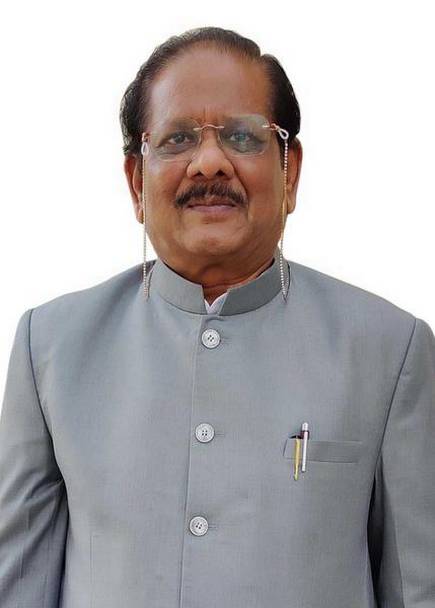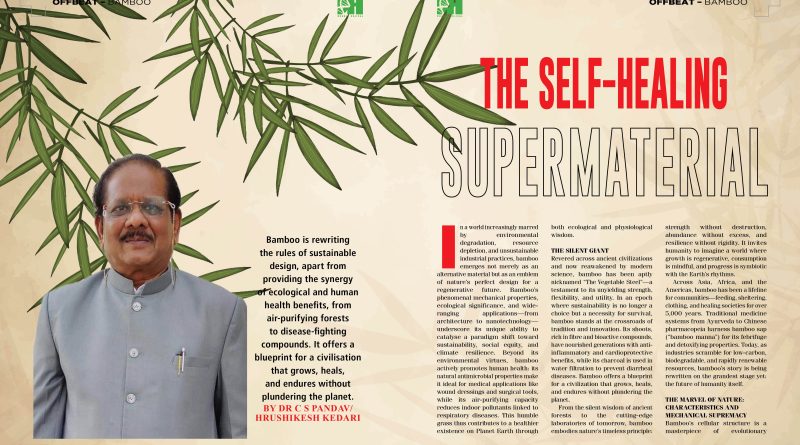The Self-Healing Supermaterial

Bamboo is rewriting the rules of sustainable design, apart from providing the synergy of ecological and human health benefits, from air-purifying forests to disease-fighting compounds. It offers a blueprint for a civilisation that grows, heals, and endures without plundering the planet.
By Dr C S Pandav/Hrushikesh Kedari
In a world increasingly marred by environmental degradation, resource depletion, and unsustainable industrial practices, bamboo emerges not merely as an alternative material but as an emblem of nature’s perfect design for a regenerative future. Bamboo’s phenomenal mechanical properties, ecological significance, and wide-ranging applications—from architecture to nanotechnology—underscore its unique ability to catalyse a paradigm shift toward sustainability, social equity, and climate resilience. Beyond its environmental virtues, bamboo actively promotes human health: its natural antimicrobial properties make it ideal for medical applications like wound dressings and surgical tools, while its air-purifying capacity reduces indoor pollutants linked to respiratory diseases. This humble grass thus contributes to a healthier existence on Planet Earth through both ecological and physiological wisdom.

The Silent Giant
Revered across ancient civilizations and now reawakened by modern science, bamboo has been aptly nicknamed “The Vegetable Steel”—a testament to its unyielding strength, flexibility, and utility. In an epoch where sustainability is no longer a choice but a necessity for survival, bamboo stands at the crossroads of tradition and innovation. Its shoots, rich in fibre and bioactive compounds, have nourished generations with anti-inflammatory and cardioprotective benefits, while its charcoal is used in water filtration to prevent diarrheal diseases. Bamboo offers a blueprint for a civilization that grows, heals, and endures without plundering the planet.

From the silent wisdom of ancient forests to the cutting-edge laboratories of tomorrow, bamboo embodies nature’s timeless principle: strength without destruction, abundance without excess, and resilience without rigidity. It invites humanity to imagine a world where growth is regenerative, consumption is mindful, and progress is symbiotic with the Earth’s rhythms.
Across Asia, Africa, and the Americas, bamboo has been a lifeline for communities—feeding, sheltering, clothing, and healing societies for over 5,000 years. Traditional medicine systems from Ayurveda to Chinese pharmacopeia harness bamboo sap (“bamboo manna”) for its febrifuge and detoxifying properties. Today, as industries scramble for low-carbon, biodegradable, and rapidly renewable resources, bamboo’s story is being rewritten on the grandest stage yet: the future of humanity itself.

The Marvel of Nature: Characteristics and Mechanical Supremacy
Bamboo’s cellular structure is a masterpiece of evolutionary engineering. With a tensile strength of up to 28,000 psi (pounds per square inch)—surpassing even steel (24,000 psi)—bamboo demonstrates nature’s unparalleled genius (Nan, 2016). Its strength-to-weight ratio rivals the finest carbon fibre composites, while its flexural strength enables it to bend gracefully under pressure, resisting fractures even during earthquakes and cyclones.
Microscopically, bamboo’s vascular bundles are densely packed and longitudinally oriented, optimizing the material for axial loading—much like the rebar inside reinforced concrete. Furthermore, its natural lignin content acts as a biological epoxy, providing exceptional durability. Bamboo can also self-heal minor fractures through lignification over time, a property still unmatched by any synthetic material engineered by humanity. This regenerative capacity mirrors the human body’s own healing processes, inspiring biomedical research into self-repairing implants and scaffolds for bone regeneration.
Interesting Fact:
Bamboo can withstand compression twice as well as concrete and tension rivalling steel, while regenerating itself in a fraction of the time.
Bamboo and the Planet: A Partnership Forged in Carbon
Environmental scientists hail bamboo as Earth’s ultimate carbon sink. One hectare of bamboo can absorb 12 tonnes of carbon dioxide per year—compared to 2-4 tonnes by equivalent hardwood forests (Lobovikov et al., 2009). Moreover, bamboo releases 35 per cent more oxygen into the atmosphere than an equivalent mass of trees.
Bamboo’s regenerative cycle is nothing short of miraculous:
• Maturity in 3–5 years (compared to 25–70 years for timber).
• Harvest without replanting: Its underground rhizome system ensures continual growth without soil erosion.
• Zero-waste resource: Every part of the plant—from shoots to roots—can be utilised, minimising ecological footprint.
Moreover, bamboo cultivation restores degraded lands, prevents desertification, and enhances biodiversity, aligning perfectly with the United Nations’ Sustainable Development Goals (SDGs) 13, 15, and 17.
Carbon Sequestration Infographic:
“Bamboo vs Hardwood Forest – CO₂ Absorption per Hectare per Year
Transforming Industries: Bamboo’s Revolutionary Applications
1. Architecture and Construction: Green Cathedrals of the Future
From the ingenious bridges of Vietnam to the ethereal bamboo cathedrals in Bali, bamboo is redefining structural aesthetics and resilience.
• Modern engineered bamboo composites (like laminated bamboo panels and bamboo scrimper) outperform traditional hardwoods and steel reinforcements.
• The Green School Bali and Elora Hardy’s Ibuku Designs are global showcases of bamboo’s limitless architectural expression.
Bamboo’s seismic resistance has led UNESCO to recommend bamboo architecture in earthquake-prone regions like Nepal and Haiti.
2. Textiles: Weaving the Future
Bamboo’s cellulose fibres create fabrics that are:
•Naturally antibacterial (eliminating 99.8 per cent bacteria).
•Moisture-wicking, thermo-regulating, and hypoallergenic.
•Biodegradable within 3-6 months after disposal.
The global bamboo textile market, valued at USD 1.7 billion in 2022, is projected to grow at a CAGR of 6.2 per cent till 2030 (Grand View Research, 2023).
Luxury brands like Stella McCartney and Patagonia are embracing bamboo fibres as their sustainable cornerstone.
3. Technology and Nanomaterials: A New Age of Green Innovation
Recent breakthroughs in bamboo nanocellulose have led to the creation of:
• Flexible, biodegradable electronic circuits.
• High-strength bio-composites for automobiles and aerospace.
• Smart bamboo materials for renewable energy storage (supercapacitors and batteries).


China, Japan, and Germany are investing heavily in bamboo nano-research projected to be worth USD 800 million by 2028.
Future Horizons: Genetic Marvels and Industrial Breakthroughs
Biotechnologists are unlocking bamboo’s deeper secrets:
• Gene editing (CRISPR-Cas9) is enhancing traits like pest resistance, frost tolerance, and fibre density.
• Vertical farming models are being piloted to grow bamboo in urban environments.
• 3D-printed bamboo bioplastics could soon revolutionise furniture, packaging, and medical implants.
Emerging projects, such as the International Bamboo and Rattan Organization (INBAR)’s Bamboo for Climate Action program, envision bamboo forests becoming carbon credit powerhouses.
Challenges and the Road Ahead
Despite its prowess, bamboo’s global ascendancy faces challenges:
•Lack of standardised industrial norms (ISO standards are evolving).
•Geographic and climatic constraints on commercial species.
•Misconceptions around durability without proper treatment.
Solutions are emerging through global bamboo certification frameworks, eco-labels, and greater R&D investment.
If nurtured wisely, bamboo could fuel a USD 80 billion global industry by 2035, lifting millions out of poverty while healing the planet.
Takeaways
Bamboo is not the ‘Future’. Bamboo is the ‘NOW’.
More than a material, bamboo is a philosophy—a way of harmonising human ambition with ecological stewardship. In its hollow strength, silent growth, and regenerative cycle, bamboo teaches us that the mightiest structures are those that bend, not break; that progress can be swift yet sustainable.
In a time, desperate for solutions, bamboo rises, not as a relic of the past, but as the architect of a living, healthier, greener civilisation. And perhaps, just perhaps, it holds the keys to humanity’s most important blueprint: a thriving Earth for generations yet unborn.
(The authors are Padmashree and Former Professor & Head, Centre for Community Medicine, All India Institute of Medical Sciences (AIIMS), New Delhi/ Adjunct Professor, Symbiosis Skills and Professional University, Pune)

